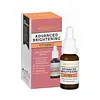What's inside
What's inside
 Key Ingredients
Key Ingredients

 Benefits
Benefits

 Concerns
Concerns

 Ingredients Side-by-side
Ingredients Side-by-side

Water
Skin ConditioningAscorbyl Tetraisopalmitate
AntioxidantSqualane
EmollientCoco-Caprylate
EmollientDimethyl Isosorbide
SolventGlycerin
HumectantBetaine
HumectantSimmondsia Chinensis Seed Oil
EmollientPotassium Cetyl Phosphate
EmulsifyingTocopherol
AntioxidantHelianthus Annuus Seed Oil
EmollientRosa Canina Fruit Oil
EmollientXanthan Gum
EmulsifyingCetearyl Alcohol
EmollientSodium Phytate
Potassium Sorbate
PreservativeBenzyl Alcohol
PerfumingGlyceryl Laurate
EmollientCitric Acid
BufferingSodium Citrate
BufferingHydroxyethyl Acrylate/Sodium Acryloyldimethyl Taurate Copolymer
Emulsion StabilisingParfum
MaskingWater, Ascorbyl Tetraisopalmitate, Squalane, Coco-Caprylate, Dimethyl Isosorbide, Glycerin, Betaine, Simmondsia Chinensis Seed Oil, Potassium Cetyl Phosphate, Tocopherol, Helianthus Annuus Seed Oil, Rosa Canina Fruit Oil, Xanthan Gum, Cetearyl Alcohol, Sodium Phytate, Potassium Sorbate, Benzyl Alcohol, Glyceryl Laurate, Citric Acid, Sodium Citrate, Hydroxyethyl Acrylate/Sodium Acryloyldimethyl Taurate Copolymer, Parfum
Water
Skin ConditioningLactococcus Ferment Lysate
Skin ConditioningGlycerin
HumectantButylene Glycol
HumectantPolysorbate 20
EmulsifyingNiacinamide
SmoothingPanthenol
Skin ConditioningCucumis Sativus Fruit Extract
EmollientBeta Vulgaris Root Extract
Skin ConditioningDaucus Carota Sativa Extract
PerfumingAvena Sativa Bran Extract
AbrasiveHydrolyzed Hemp Seed Protein
Skin ConditioningAloe Barbadensis Leaf Extract
EmollientZingiber Officinale Root Extract
MaskingSodium Hyaluronate
HumectantFructooligosaccharides
HumectantBiotin
AntiseborrhoeicAcrylates/C10-30 Alkyl Acrylate Crosspolymer
Emulsion StabilisingCetyl Stearate
EmollientPyridoxine Hcl
Skin ConditioningPentylene Glycol
Skin ConditioningCetyl Alcohol
EmollientIsostearyl Isostearate
EmollientPotassium Cetyl Phosphate
EmulsifyingSodium PCA
HumectantSodium Phytate
Hydroxyphenyl Propamidobenzoic Acid
Skin ConditioningStearic Acid
CleansingPotassium Lactate
BufferingSodium Chloride
MaskingCitric Acid
BufferingLactic Acid
BufferingSodium Hydroxide
BufferingPotassium Sorbate
PreservativeSodium Benzoate
MaskingCaprylyl Glycol
EmollientPhenoxyethanol
PreservativeDecyl Glucoside
CleansingLauryl Glucoside
CleansingWater, Lactococcus Ferment Lysate, Glycerin, Butylene Glycol, Polysorbate 20, Niacinamide, Panthenol, Cucumis Sativus Fruit Extract, Beta Vulgaris Root Extract, Daucus Carota Sativa Extract, Avena Sativa Bran Extract, Hydrolyzed Hemp Seed Protein, Aloe Barbadensis Leaf Extract, Zingiber Officinale Root Extract, Sodium Hyaluronate, Fructooligosaccharides, Biotin, Acrylates/C10-30 Alkyl Acrylate Crosspolymer, Cetyl Stearate, Pyridoxine Hcl, Pentylene Glycol, Cetyl Alcohol, Isostearyl Isostearate, Potassium Cetyl Phosphate, Sodium PCA, Sodium Phytate, Hydroxyphenyl Propamidobenzoic Acid, Stearic Acid, Potassium Lactate, Sodium Chloride, Citric Acid, Lactic Acid, Sodium Hydroxide, Potassium Sorbate, Sodium Benzoate, Caprylyl Glycol, Phenoxyethanol, Decyl Glucoside, Lauryl Glucoside
Ingredients Explained
These ingredients are found in both products.
Ingredients higher up in an ingredient list are typically present in a larger amount.
Citric Acid is an alpha hydroxy acid (AHA) naturally found in citrus fruits like oranges, lemons, and limes.
Like other AHAs, citric acid can exfoliate skin by breaking down the bonds that hold dead skin cells together. This helps reveal smoother and brighter skin underneath.
However, this exfoliating effect only happens at high concentrations (20%) which can be hard to find in cosmetic products.
Due to this, citric acid is usually included in small amounts as a pH adjuster. This helps keep products slightly more acidic and compatible with skin's natural pH.
In skincare formulas, citric acid can:
While it can provide some skin benefits, research shows lactic acid and glycolic acid are generally more effective and less irritating exfoliants.
Most citric acid used in skincare today is made by fermenting sugars (usually from molasses). This synthetic version is identical to the natural citrus form but easier to stabilize and use in formulations.
Read more about some other popular AHA's here:
Learn more about Citric AcidGlycerin is already naturally found in your skin. It helps moisturize and protect your skin.
A study from 2016 found glycerin to be more effective as a humectant than AHAs and hyaluronic acid.
As a humectant, it helps the skin stay hydrated by pulling moisture to your skin. The low molecular weight of glycerin allows it to pull moisture into the deeper layers of your skin.
Hydrated skin improves your skin barrier; Your skin barrier helps protect against irritants and bacteria.
Glycerin has also been found to have antimicrobial and antiviral properties. Due to these properties, glycerin is often used in wound and burn treatments.
In cosmetics, glycerin is usually derived from plants such as soybean or palm. However, it can also be sourced from animals, such as tallow or animal fat.
This ingredient is organic, colorless, odorless, and non-toxic.
Glycerin is the name for this ingredient in American English. British English uses Glycerol/Glycerine.
Learn more about GlycerinPotassium Cetyl Phosphate is the potassium salt of a mixture. This mixture consists of the esters from phosphoricacid and cetyl alcohol.
Potassium Cetyl Phosphate is an emulsifier and cleansing agent. Emulsifiers help stabilize a product. It does this by preventing certain ingredients from separating.
As a cleansing agent, Potassium Cetyl Phosphate helps gather oils, dirts, and pollutants from your skin. This makes it easier to rinse them away with water.
Learn more about Potassium Cetyl PhosphatePotassium Sorbate is a preservative used to prevent yeast and mold in products. It is commonly found in both cosmetic and food products.
This ingredient comes from potassium salt derived from sorbic acid. Sorbic acid is a natural antibiotic and effective against fungus.
Both potassium sorbate and sorbic acid can be found in baked goods, cheeses, dried meats, dried fruit, ice cream, pickles, wine, yogurt, and more.
You'll often find this ingredient used with other preservatives.
Learn more about Potassium SorbateSodium Phytate is the synthetic salt form of phytic acid. Phytic acid is an antioxidant and can be found in plant seeds.
Sodium Phytate is a chelating agent. Chelating agents help prevent metals from binding to water. This helps stabilize the ingredients and the product.
Water. It's the most common cosmetic ingredient of all. You'll usually see it at the top of ingredient lists, meaning that it makes up the largest part of the product.
So why is it so popular? Water most often acts as a solvent - this means that it helps dissolve other ingredients into the formulation.
You'll also recognize water as that liquid we all need to stay alive. If you see this, drink a glass of water. Stay hydrated!
Learn more about Water